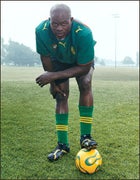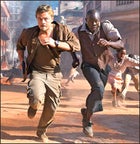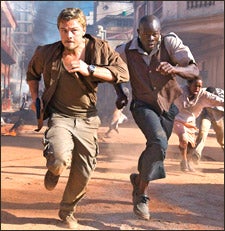Conflict diamondsraw stones mined in war zones and illegally traded to fund rebel militiasmade international headlines in the nineties, during the violent civil war in Sierra Leone that left tens of thousands dead. The issue regains the spotlight on December 8, when Blood Diamond, starring Leonardo DiCaprio, Djimon Hounsou, and Jennifer Connelly, opens in U.S. theaters. Directed by Edward Zwick (The Last Samurai) and set in Sierra Leone, the story centers on a rare pink diamond discovered by Solomon Vandy (Hounsou), a local fisherman forced by militants to work in the diamond fields, and his relationship with an opportunistic smuggler (DiCaprio) who wants the stone for himself. ANTHONY CERRETANI spoke with Benin-born Hounsou, 42, a few weeks before Blood Diamond's premiere.
Djimon Hounsou
 SOCCER ACADEMY: Hounsou, at play in L.A., is generating early Oscar buzz.
SOCCER ACADEMY: Hounsou, at play in L.A., is generating early Oscar buzz.Leonardo DiCaprio & Djimon Hounsou
 Leonardo DiCaprio and Djimon Hounsou in Blood Diamond
Leonardo DiCaprio and Djimon Hounsou in Blood Diamond��
OUTSIDE: This film is an adventure story at heart: Your character treks through jungles and mountainous rebel territory to recover a hidden diamond.
HOUNSOU: The shoot was very physical and emotionalbeing chased, running left and right in the bush, day in and day out. There was nothing about it that was easy. Hopefully the movie's message will come through; people who see it will have a better understanding of what went down and, in some places, is still going down.
Is that what drew you to this projectthe opportunity to bring the situation to light?
Africa is my continent. It is where I opened my eyes. The more awareness we can bring to an issue there, the more people will rally the leaders of developed countries to do something about it.
Some major diamond companies have voiced concerns that by drawing attention to a problem of the past, this film will hurt their holiday sales. Yet the London-based human-rights group Global Witness says that while conflict stones now account for less than 1 percent of the global diamond trade, that figure doesn't reflect the ongoing problems caused by smuggling in certain regions.
It helps certain people in the industry to think the problem doesn't exist anymore. Obviously, things have toned down in Sierra Leone, but people are still dying, and being displaced, over conflict diamonds in countries like the Democratic Republic of the Congo. It's not enough to get it down to even 1 percent when the abuse and the use of child soldiers is continuing.
What needs to happen?
I hope more people will ask diamond companies to continue changing the way they do business in Africa. They've done well mining in certain countries; now they can put more of the money back into those countries and do what's right.
So will we flush our diamonds down the drain after seeing the film?
No, it's more like you'll say, “I'd like to have a diamond but wear it comfortably. I want to make sure nobody died because of it.”
For more information on the diamond trade, and what you can do to ensure that the diamonds you buy are conflict-free, visit or .


